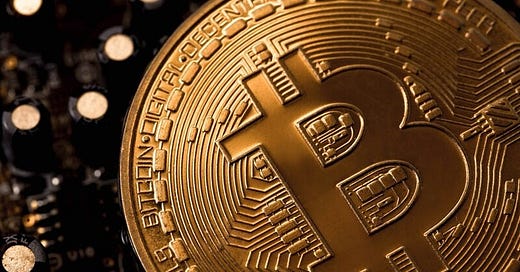Here’s the bonus column we promised -- you should be able to read it in four or five minutes. Know somebody that needs to hear this? Share with them here:
Bitcoin prices fell 9% last week, capping off a two week period where the benchmark cryptocurrency lost 30% of its value. This may have been a “flesh wound” for an asset that appreciated by 300% last year, but major looming risks and deep misunderstandings about the nature of money itself could mean more turmoil to come.
Bitcoin is a pure speculative vehicle: there are no assets underlying it that generate returns on capital. Like all speculative vehicles, buyers hope to later resell their coins to another purchaser at a higher price for no reason other than rising market demand.
Luckily for Bitcoin speculators, the past year has seen a major new class of “greater fools” willing to bid its price up: institutional investors. Just last week BlackRock, the world’s largest asset manager, filed notice with the SEC that it would add Bitcoin exposure to two of its investment funds. The trend began last May when hedge fund manager Paul Tudor Jones revealed that he had put 1-2% of his money into the cryptocurrency, calling it “a great speculation.”
Jones and others have argued that there is actually a reason for rising demand for Bitcoin: hyper-loose central bank monetary policies threatening inflation. But JPMorgan Chase asset strategists last week revealed new evidence that it is historically a bad hedge against price movements in the market. The entire Bitcoin market is tiny, giving retail investor fads an outsized influence on its price. The same demand peaks and valleys that raise or lower stock prices drive investors into and out of Bitcoin.
Bitcoin is different from traditional hedges like gold in more fundamental ways too. Money exists as a medium for exchanging commodities. Commodities come first, a currency’s role as a store of value is a function of its ability to command commodities on the market.
Bitcoin is an intentionally deflationary currency: it guarantees increasing scarcity over time. But if its price tends to rise, why should any holders ever buy goods or services with their crypto today? Tomorrow they will be able to buy more with the same coin. This is why almost nobody uses Bitcoin to exchange legal commodities, and without adoption as a medium of exchange, its role as a store of value has no future.
As for gold, before modern central banks and superpower states, the only way to ensure relative stability between the value of money and the value of commodities -- i.e. how much work a society needs to expend to produce them -- was to pick a representative commodity whose value would move with commodity values at large whenever things like industrialization or plagues made things easier or harder to produce.
Gold’s historic role as the most common representative money commodity means that global markets implicitly assume that it could reassume this function if the current monetary system were to collapse. This makes gold a necessary hedge for reserve holders, something that is not true for Bitcoin.
And Bitcoin may have even less ground beneath its feet than its supporters assume. A 2018 research paper by economists John Griffin and Amin Shams found that during its 2017 price runup, gains in Bitcoin were strongly correlated with issuance of Tether, a “stablecoin” digital currency supposedly backed one-to-one by the U.S. dollar. Bitcoin gained 50% of its value after just 87 Tether-to-Bitcoin transactions, purchases that accounted for less than 1% of the time period Griffin and Shams examined. Ten thousand computer simulations could not repeat this outcome.
Tether is controlled by the same executives who own one of Bitcoin’s major exchanges, Bitfinex. Bitcoin skeptics believe that Tether is printing its digital currency out of thin air -- without any dollars backing it -- and using it to “buy” Bitcoin on Bitfinex, raising Bitcoin’s price. The company is now subject to a New York Attorney General investigation, and last week it asked for a second delay in fulfilling document requests that could expose the company.
If Tether is a fraud, then a substantial portion of Bitcoin’s market cap could go up in smoke. At the same time, its limited use cases -- money laundering and criminal commerce -- are under new attack. Prices plummeted last week when U.S. Treasury Secretary-nominee Janet Yellen called it “a particular concern” used “mainly for illicit financing.”
New proposed U.S. regulations issued in the Trump administration’s waning days would require all Bitcoin exchanges to “know their customers” and report transactions over $10,000 to the federal government, as well as all transactions over $3,000 made to “private wallets.” If these go through, Bitcoin will lose the currency’s sole advantage over conventional money: its anonymity.
There is no real way to know when or how Bitcoin’s story ends. Regulation could actually make it more legitimate, maybe Tether is on the up and up, or maybe its blow to Bitcoin’s value will be less than fatal. Maybe the asset will “go to zero” as many have predicted. We do know that it has at least one thing going for it: there’s rarely a shortage of “greater fools” in this global economy.
Disclaimer
Our only investment advice: Long Paddy’s dollars.
Contact us with questions, feedback, or stories we might have missed.




